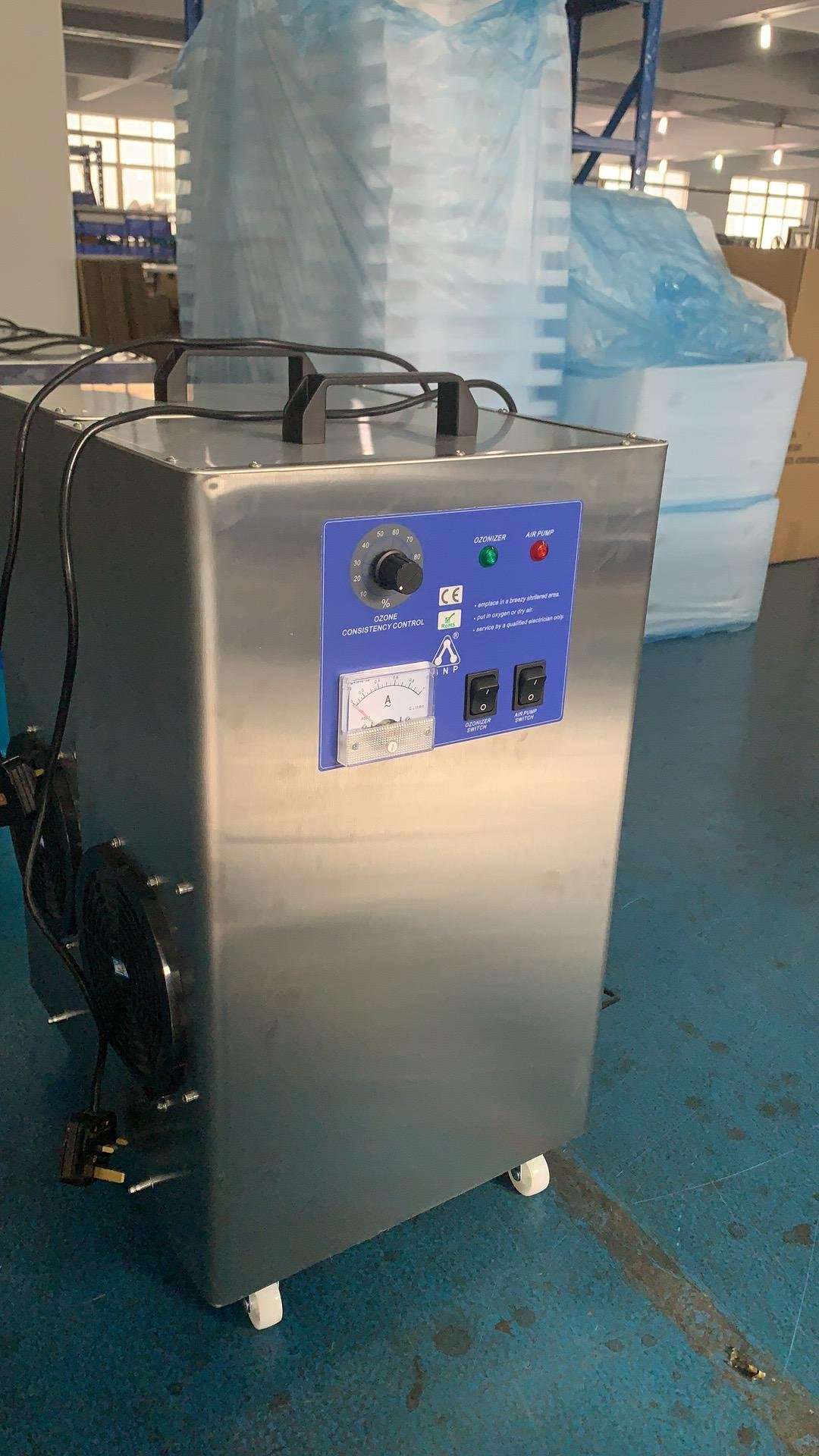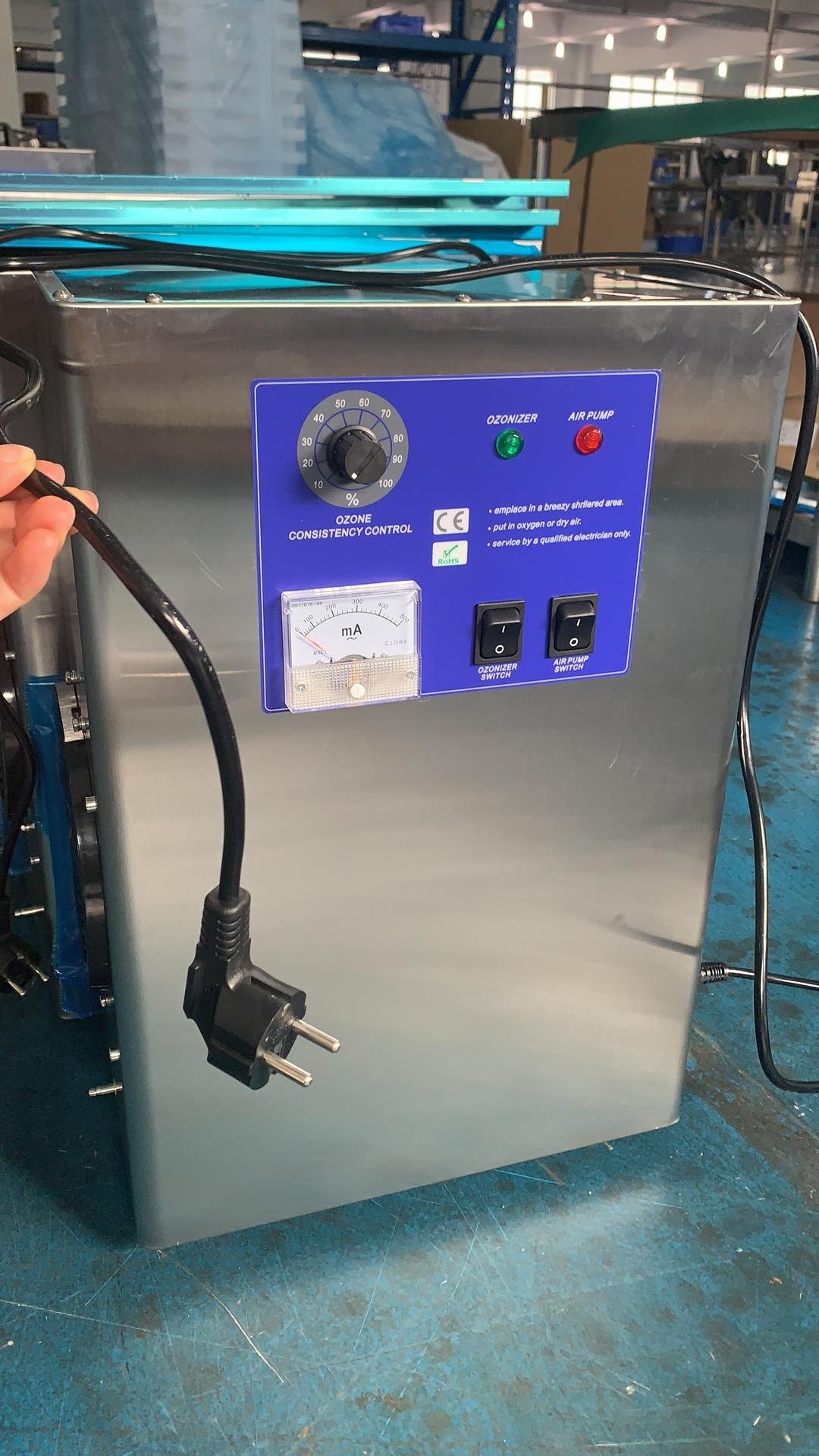3g/h ozone generator, multipurpose air and water, air or oxygen source
Model No.︰GSL-H3G
Brand Name︰-
Country of Origin︰China
Unit Price︰US $ 300 / pc
Minimum Order︰1 pc
Product Description
3G/H, 5G/H,10g/h and 15g/h ozone generator
applicable for air or oxygen source
multipurpose for air and water treatment
Optional for electric air dryer
strong ozone output
ozone concentration adjustable (0-100%)
strong air pump
continuous work
Technical parameters
| GSL-H3G | GSL-H5G | |
|
Ozone output (g/h) (oxygen source) |
10 | 15 |
|
Ozone output (g/h) (air source) |
2.5 | 3.5 |
| Cooling method | air cooled | air cooled |
| Maximum ozone concentration (g/m3) |
Oxygen source:25~50 Dry air source:5~15 |
|
| L*W*H (mm) | 350×250×520 | 350×250×580 |
| Weight (kg) | 11 | 12 |
| Max operating current | ≤0.3 A | ≤0.55 A |
| Interface sizes | Ozone-resisting silicon tube Φ6.5mm | |
| Power (W) | 140 | 160 |
| Gas source | When using oxygen (oxygen cylinder or oxygen generator) or dry air source, the input pressure to ozone generator must be≤0.2MPa(≤2kgf/c ㎡); Medical oxygen pressure reducing valve should be used for oxygen air source; | |
| Timing | Continuous work, can work with external time transformer; can provide built-in timer for quantity order | |
Brief introduction of GSL-H series ozone generator
IGBT technique (from Germany Infineon Technologies AG) is adopted in this series of ozone generators.
Ozone is generated by corona discharge, and the discharge chamber is composed of de-hydroxyl tube-form generators.
Particular anti-backwater design makes its service life much longer than that of ordinary factories.
Modular design is adopted in electrical circuit. Dielectric element, pipeline and fastening for conveying ozone are all ozone-resistant to ensure long service life, enough corona density, low temperature, and much higher ozone concentration.
Composition
Generator unit (electric circuit board, high-voltage generator, discharge chamber),
stainless steel external cabinet,
65L air pump (maybe some products are not equipped with 65L air pumps), ammeter, 150 type fan from Taiwan, connection tube line, ozone regulating apparatus, indicating light.
As one of the most powerful oxidants, ozone is a colorless gas with little offensive smell of grass, and is a generally-admitted environment-friendly disinfectant. Ozone is the allotropicity of oxygen, with same element composition but different structural appearance, and their performances are quite different.
Ozone is used in four fields, i.e. water treatment, chemical oxidation, food processing and medical treatment.
Water treatment--Ozone can effectively and rapidly kill bacteria, virus and other microbes in water; completely remove organic compound and other pollutant, but not bring about secondary pollution. There will be chloroform, bromine dichloromethane, carbon tetrachloride and other chloridized organics (THM) with carcinogenicity, if polluted water source is treated by chlorinating. Using ozone in treatment, there will be no secondary pollutant. Sewage treatment includes civil sewage, industrial sewage and medical sewage, with main purse of sterilizing, removing pollutant, decolorizing and eliminating stink to meet discharge standard. Treating swimming pool water with ozone, the water will be limpid and transparent, and some problems caused by using chlorine, such as yellow hair and stimulation on eyes, skin and respiratory tract will be thoroughly settled. Its effectiveness and advantage have been generally accepted.
Cooling Tower Association of USA has recommended using ozone to treat cooling recycle water to reduce and remove incrustations, disinfect and eliminate algae, prevent corrosion and stabilize water quality.
Chemical oxidation--Ozone has been used in chemical engineering, petroleum, paper making, textile, pharmacy, spice and other industries, as oxidant, catalyst and refining agent. The powerful oxidation capacity of ozone can easily break carbon chains in alkenes, alkyne organics, and partially oxidize them to form new chemical compounds. In purifying biological and chemical air pollutant, stink in factories processing furs, coating enterics and fish, polluted gas in rubber and chemical factories can all be decomposed and eliminated by ozone. Ozone works as a catalyst in pesticide synthesis, but to some pesticide remains, it can also oxidize and decompose them.
Food processin--Given its powerful sterilization capacity and advantage of zero polluted remains, ozone is widely used in food processing industry for disinfection and stink removal, mould control and refreshing. Food and Drug Administration revised the stipulation that always deemed ozone as food additive and limited its use in April, 1997, allowing using ozone in food processing and storage without authorization. It has great influence in enhancing technical progress and improving food quality.
Medical treatment--It’s mainly used for air sterilization in sickroom and operating room that ozone is generalized in China, but many therapeutic researches have been conducted abroad. Physicians and dentists in Germany, Switzerland, Russia, France and Italia have applied ozone in treatment for many years, such as using ozone water in oral operation and artificial teeth mounting to keep oral cavity gem free, treating cancer with ozone and radiation therapy combined, drinking ozone water to cure gynecological diseases, and injecting ozone to cure fistula, piles and varicosity, etc.
Proper use of ozone is safe and harmless
As a gaseous sterilant, ozone can effectively kill virus, bacterium, mould and other microbes depending on its oxidization capacity. Like any antiseptic, it will cause certain physiological reaction and even damage, but the amount is much less than normal antiseptics, and is easier to protect. On smelling its specific odor, mucous membrane in respiratory tract will cause dry mouth and cough; strong stimulation will cause sore throat and lassitude; it will need a few hours to recover, but there is still not a case of death caused by ozone. As an antiseptic with vigorous sterilization capacity, ozone can automatically decompose, leaving no any remaining pollution. Discomfort will immediately vanish once leaving the site, and it’s hard for formaldehyde, peroxyacetic acid, potassium permanganate, and other common antiseptics to match.
Industrial health standards for ozone: International Ozone Association: 0.1PPm, contact period 10 hours. USA: 0.1 PPm ,contact period 8 hours. Germany, France, Japan: 0.1PPm. China PR: 0.15.
Payment Terms︰ T/T
Product Image


